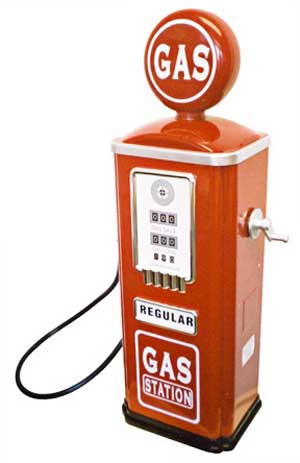 A good, quick guide for keeping track; from CNNMoney:
A good, quick guide for keeping track; from CNNMoney:
The spike in oil last week could translate to an increase in gas prices of 37 cents per gallon in the coming weeks, according Moody’s Analytics economist Chris Lafakis. He estimates that for every $1 increase in the price of oil, retail gas prices typically rise 2.5 cents a gallon.
Gasoline is a product depending entirely on oil.
At the end of the day Friday, oil settled at $97.88, down from a high of $103 Thursday but still up 13 percent over the last week.
The oil-to-gas pump-process does indeed exhibit a not-so-slow trickle down effect: Up here along the northern California coast, in less than a week, gas prices have jumped a dime — the last I looked, $3.89 a gallon for regular.
(Illustration found here).
Last Wednesday, in a rare, financial/news/life event, I decided the shit horrifying Libya right now might make already-high gas prices even higher, and thusly, in another even-more rare action, I filled up my Jeep Comanche’s gas tank — usually I just put $20-at-time — at my normal Union-76 station with the price of regular set at $3.79 a gallon.
And on Saturday, as I was out and about, the general gas-station billboard had regular at $.10 more — a spike made actually in just three days.
Cost for certain stuff is higher here in Humboldt County, among that stuff is fuel — regular gas found in my former San Luis Obispo residence (located on California’s central coast, midway twixt LAX and SFO) is $.23 cheaper, at least as of this morning (Sunday).
This area up here is way-higher than the national average — $3.35 — and even higher than, though not that much, from California’s own state average — $3.71 a gallon.
As I don’t really drive that much any more, the next few days I’ll be ahead of the curve, be able to cruise gas stations not only with impunity, but also a certain glorious, financially-felt emotion of “I Beat You!“
However, in just a few days, maybe gauged down in hours, that dime will have evaporated quicker than gasoline stench on concrete.
Seriously worrisome is how fragile and how quick the entire oil panoramic-picture reacts to stimuli — Libya is only the 17th-largest producer in the world, and which at its height, yielded a crude oil output of 1.6 million barrels per day (bpd) (Reuters).
In comparison: Two years ago (2009) and according to estimates from the US CIA, Russia is the planet’s biggest oil producer at 9.9 bpd, much-closely followed by Saudi Arabia at near 9.8 — Libya shouldn’t be that awesome of a deal, yet…
In just 11 days, Libya’s oil production has plunged some 90 percent, dropping from that 1.6 million figure to 850,00 bpd — one complex, 200km west of Benghazi, has seen production rapidly descend from 90,000 bpd to just 11,000.
Even this has caused a shit-storm within the oil-production system.
In one particular view, from the UK’s The Telegraph, a major oil-price spike could lead the US into a recession, this based on history: Ever since the early 1970s, every single time oil prices have spiked sharply (rising by 80pc or more), regular as clockwork the US has entered recession. Given America’s massive influence on worldwide economic sentiment, the past five global recessions have all come in the wake of sharp jumps in the price of crude.
Some shit, huh?
Well, it’s some shit that shouldn’t have been there in the first place, and the cheap-shit variety is gone, leaving civilization holding a wet, empty bag, bringing forth now that infamous back-burner of a problem, peak oil, or in reality, the end of inexpensive oil.
In an interesting post in Foreign Policy Journal, Jeremy Hammond, notes the time is more-than nigh to confront the machinery of oil consumption.
A couple of snips from the piece published this morning:
Peak Oil is often called a “theoryâ€, as though it wasn’t a fact that oil is a finite resource, and as though it wasn’t a mathematical reality that production must peak, just as global oil discovery peaked in the 1960s, and just as U.S. domestic oil production peaked in the early 1970s.
That oil production must reach a peak, after which point it must decline, is not some kind of paranoid delusion.
It’s a mathematical certainty we’ve already witnessed as historical fact, on the national scale.
Global peak oil production is likewise not a question of if but when.
According to world-renowned petroleum geologist Dr. Colin Campbell, the data shows that the peak of world oil production is already behind us, having occurred sometime between 2005 and 2008.
As Campbell also points out, “Today, 29 billion barrels of oil a year support 6.8 billion people with an energy supply equivalent to that of billions of slaves working around the clock.â€
…
The sky is not falling.
But Peak Oil is most assuredly upon us, and if we don’t start rethinking our ways and changing our habits now, the consequences will be disastrous.
We can choose our future.
We can choose to ignore Peak Oil, delude ourselves into thinking that cheap energy will continue to be available into the foreseeable future, and continue on present course; or we can recognize that Peak Oil is a reality, that the end of the age of cheap oil is nigh, and make the changes required, both on an individual and societal basis, in order to prepare for what’s coming and have some kind of framework in place to be able to deal with it and avert, or at least mitigate, catastrophe.
Humanity has a lot on its collective plates nowadays — I fear fear, and thus some kind of knotted bowel constriction, thus not allowing harmful, noxious gases from escaping, leading to a horrifying kind of personal implosion — a gas removal pump, that’s it, yeah!